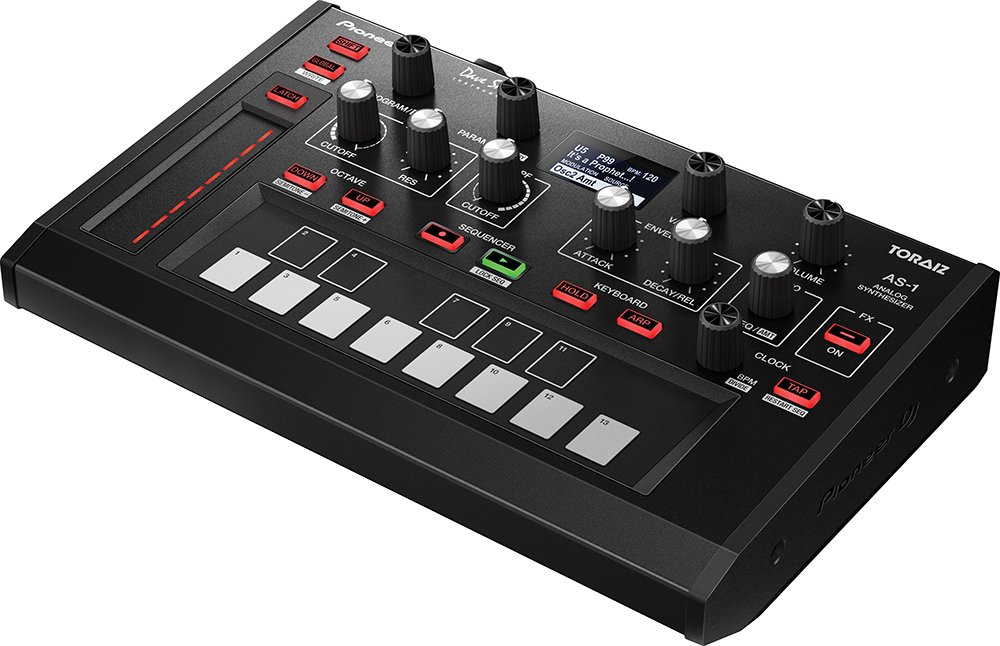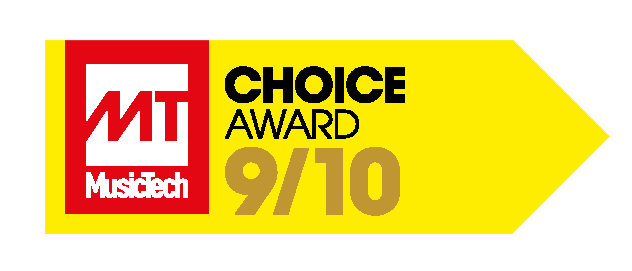Pioneer DJ Toraiz AS-1 Review – Another Successful Crossover
The new Toraiz from Pioneer DJ is another crossover unit packed with DSI goodness – a mono Prophet-6 analogue synth for less than £500 and a lot more besides. Can Andy Jones resist?



Details
Kit Toraiz AS-1
Manufacturer Pioneer DJ
Price £479 (street)
Contact www.pioneerdj.com
![]()
With the RM speaker range, Pioneer announced some serious music- production intentions – they are rock solid monitors, from a company that made its name equipping DJs with some of the best gear around. Pioneer then strengthened its production hand with the Toraiz SP-16 sampler, a hardware beast that utilises Dave Smith Filters and is, as reviewer Martin Delaney said: “One of the most fun hardware experiences I’ve had in ages”. That unit is aimed at Akai MPC beatmakers, or DJs who want a quick way of adding hits, loops and other samples to their sets.
Now, we have a new Toraiz on review, the AS-1, which was one of the standout products of NAMM 2017. This was largely down to the fact that this Toraiz packs in even more DSI sound: an analogue synth based on the company’s Prophet 6…
Let’s work together
My theory on the Pioneer DJ and DSI link up is that they simply got chatting at NAMM a few years back, as their stands are next to each other at the annual gear show – a romantic notion of how gear is designed and built, I know, but whatever, the results are unexpectedly beneficial to both parties.
The SP-16 features the Prophet-6 filters to give it its edge – but I’d argue that the AS-1 goes one better, by adding a monophonic Prophet-6, one of my favourite synths of the last five years. As the full version (albeit with more controls and six times the polyphony) retails at over two grand, getting even a cut-down version for less than 500 sheets is almost the main selling point of the AS-1. But this is not ‘just’ an analogue synth.
Knowing Pioneer DJ as we do – and there’s a big clue in the name – Toraiz AS-1 very much has DJs in mind. So you might not get a full keyboard to play it, but the unit does come packed with enough synthesis features and sound-manipulating tools, performance features and an onboard sequencer and arpeggiator, to make it a creative part of a DJ’s live set.
So, Pioneer is aiming AS-1 at any DJ with production aspirations to transform their sets – partner it with the SP-16 for the beats, while the AS-1 does the melodies. And for studio users, there should be plenty to attract them, too. It’s an easy-to-use synth, with nearly 500 presets. Sound-mangling fans should like the easy edit options and easy riffs, and sequences can be made without a computer in sight.
AS hands-on
AS-1 is compact and lightweight and quite different from SP-16, as you might expect given their very different price points. There’s no touchscreen, as on the SP-16, but a single monochrome screen offers a pretty clear idea of what’s going on. There are just 11 rotaries, a single-octave touch keyboard and half a dozen buttons that have an AIRA look about them. These are for the arpeggiator, switching octaves up and down, or controlling the sequencer.
Around the back, there are two audio outs, MIDI In and Out/Thru, USB and a Trigger input to control the sequencer via a footswitch or audio. Power up the AS-1 and it’s actually quicker to dive in and go, rather than looking at the instructions. Dial up the programs, play notes, get the arpeggiator going, press the Hold button and you’re away. There may not be many rotaries, but Pioneer has made their main functions control all of the dramatic aspects of your chosen sound.
DJs then can bring in all sorts of this stuff into a live performance… all at the melodramatic turning of a couple of dials. Partner this with an SP-16 and try and stop any DJ worth their salt from programming instant breakdowns.
Genuinely, just as Mr Delaney pointed out with the SP-16, my first experiences with the AS-1 were instant fun. Dial the synth rotaries, arpeggiate and sequence. Plus, you can assign lots of different parameters to the touch strip to add yet another performance angle. Honestly, within 10 minutes of powering the thing up, you’ll believe you’re a world-class, globetrotting EDM star. I did, anyway.
However, since this is a music-production magazine, let’s look at some of the other sonic areas and options before I get too carried away and start thinking of a DJ name for myself.
Firstly, you can delve deeper into a lot of the menus and sub menus by pressing the Shift button when outside of the Sequencer or Arpeggiator modes. Hold it and dial the Param rotary to take you through the main areas of the AS-1 from its two oscillators, filters, envelope and mixer, right through to the sequencer. When you get to your chosen area, you can adjust values and parameters on certain controls using the Value and Param dials.
For example, within the touch strip, you can edit up to seven parameters that the main slider controls: from the frequency on the oscillators through to the effect amounts. It’s very easy to do, and again, Pioneer has chosen parameters that’ll change the sound dramatically with a tweak of the strip. The best bit is that you can have all seven parameters controlled by the strip for huge changes in your sound as you slide. It’s not subtle, but that’s why using AS-1 is so much fun.
The aforementioned effects are digital and also lifted from the Prophet-6. There are only seven types of effect across two effects banks, but – and I keep saying it – they’re the ones Pioneer thinks you’ll like, so they’re big and bold. The Phasers are quite superb and while the Distortion is often just a pushed phasing sound, the Ring Mod makes up for it by being very dirty. The Param dial will also lead you to the main parameters within each of the seven effect categories, so you can easily push for more if you’re left wanting, which is unlikely.
Toraiz AS-1 overview
A) Touch Strip
You’ll be using this one all of the time. It can control up to seven main parameters at once – and the amounts of which can easily be adjusted in the sub-menu system
B) Global
We didn’t talk about this in the main text, but it’s simply the button that takes you to the main parameters of the AS-1 from the main MIDI channels, right through to how the screen saver works
C) The main program button
Step through all 495 preset sounds or combine with the Shift button to step through the five factory banks and each of the 99 sounds within them. There are five user banks, too, for your own sounds
D) Display
The OLED display is not like the touch one found on the SP-16, but does offer a very clear view of all parameters and sections
E) The synth part
Pioneer has the main synth components controllable via these rotaries. You’ll notice that they’re assigned to the most dramatic sound-shaping ones
F) Sequencer
Up to 64 parts can be programmed note-by-note, by playing step-by-step over your chosen number of steps and then edited in the sub menus
G) Keyboard
It’s not a real keyboard, obviously, but fun to play or trigger. You can also assign your favourite presets to it for easy recall, which is a neat feature
H) Other controls
Finally, you get a Tap switch and BPM dial for manual-tempo adjustment and the main output dial, for overall volume level
How much Prophet?
Of course, the big boast here is the amount of Prophet-6 you get for your money. We’ve touched on the digital effects, but the main action has to be the analogue synth. I’m a proud owner of a Prophet-6 and I’d say that among its biggest strengths are its pad and bass sounds. While you do get some pad-like sound, because the AS-1 is only monophonic, it’s really the leads and basses from that synth that are best shown off here. That’s what you get, then, and to a large extent, it’s also what the dance producers and DJs who AS-1 is undoubtedly aimed at will want. And they get them in droves…
There are some great 303-like sounds from the off – of course there are, will that sound ever become completely unfashionable? Some huge basses also cut through, plenty with added distortion, which certainly helps make them stand out. The great thing about Dave Smith sounds is that not only does he do rich bass, he does deep and rich leads, too. Again, these leads might just be monophonic, but the dual oscillators produce some great and rich harmonics, which really bring warmth and fuzziness when needed.
With 495 presets on offer (plus the same again to save your own), there’s also room for some oddball stuff on top of the more standard dance sounds. So, you get occasional chip-tune sounds, more traditional sounds (Clavinet anyone?), distorted guitar-like presets, and some extreme effects, too.
Combine all of these with the performance tools I’ve covered above and you’ll realise that you can get some pretty whacky sounds out of this machine, as well as the more traditional ‘here’s the filter opening, get ready to dance’ stuff. There are only one or two duds – as there were on the Prophet-6 – a great miss rate.
This just leaves the Sequencer and Arpeggiator. You’ll want to use the latter if it isn’t automatically switched on when you dial up a preset. It, combined with the Hold button, is where your instant fun comes in and it’s easy to dial through its five modes and get riffs going. The sequencer is functional and easy to program, by playing in over your defined number of steps, note by note. You can choose up to 64 (32, 16, eight, four or two). It’s pretty easy to edit note information via the Param/Value combo described above, which allows you to alter velocity, note and slew values.
For DJs or producers?
Actually, both. I’m no DJ, but I can see how this will fit into a set or alongside the SP-16 to become a vehicle for a standalone performance. It’s almost impossible to resist the unit’s performing charms and even if you don’t DJ, or have never been tempted, a few minutes with this little beauty could give you the confidence to become a live performer.
Taken as a pure studio tool, there’s a lot to like, although you’d be missing a lot of the point if you ignored the performance aspects. Still, this has 495 DSI sounds and room for 495 more, which you’ll easily fill with such simple programming. Okay, it might not be capable of the lush chordal pads from the Prophet-6, but all of the deep basses and tearing leads are here.
Sure, other boxes – notably the Volcas, AIRAs, even the Teenage Engineering PO Series – will give you sounds to manipulate, but these are Dave Smith sounds, ferchristssakes, and for less than 500 quid! Yes, you have to put up with a touch keyboard – which I did actually grow to like more than I thought I would during this test – and there’ll always be the nagging feeling you’re not making the most of the DJ features, but if you want the DSI sound, there’s no cheaper way. Producer? Tick. DJ? Tick. Both?
No brainer. Other companies should take note: get a stand next to someone cool at next year’s NAMM. You never know what the results could be.
Alternatives
Roland Aira TB-3 – around £259
The first thing that sprung to mind when switching AS-1 on was the AIRA TB-3. They look similar in some ways, but the TB-3 is a pure and simple 303 soundalike box, albeit with a lot of variations on that theme. AS-1 does a lot more sonically, but is twice the price.
www.roland.co.uk
Korg Volca Keys – around £110
Cheaper still is the Volca Keys (or indeed, the Bass). It’s a little flimsier, but does a great analogue sound for a fraction of the cost. However, it lacks some of the AS-1’s more DJ-orientated sensibilities.
www.korg.com
Novation Circuit – around £269
Okay, the regular Novation Circuit is more of a groovebox that does beats and synth lines and is more of a standalone box than a DJ partner. However, the recently announced Circuit Mono Station effectively adds a Novation Bass Station synth – with its great mono sound – for another £200, putting it fairly and squarely right in the AS-1 camp.
uk.novationmusic.com
Toraiz AS-1 key features
- Monophonic analogue synth and 64-step sequencer
- 2 VCOs (with variable Triangle, Sawtooth and Pulse waves); 2VCFs (4-pole low and 2-pole high); 2 EGs; LFO; and VCA
- 495 presets and 495 user sounds
- Effects 1: Bucket Brigade, Distortion and Ring Modulation
- Effects 2: Chorus Low Res Phaser, High Res Phaser, Maestro Phaser
- Connections: L/R audio out, headphone out, MIDI In/Out, USB, Trigger in (via pedal or audio)
- Size (mm): 267x68x178
- Weight (kg): 1.4



